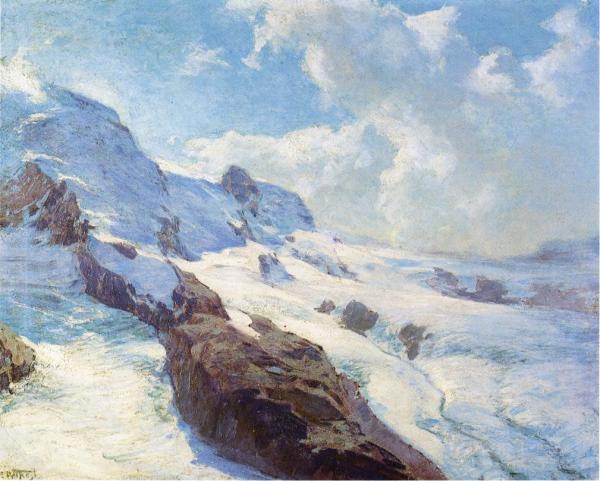-
Artist: Edward Henry Potthast (American, 1857-1927)
“American Impressionist Edward Henry Potthast is best known for sunny beach scenes, filled with sparkling surf and high-keyed details such as balloons, hats and umbrellas. He was born to a family of artisans in Cincinnati, Ohio, on June 10, 1857. At age twelve he became a charter student at Cincinnati's new McMicken School of Design. He studied at McMicken, off and on, for over a decade. From 1879 to 1881, his teacher was Thomas Satterwhite Noble. Noble, a portrait and figure painter, employed a dark palette and a rich, painterly technique derived from his instruction under French artist Thomas Couture” (1).
“Edward Potthast’s training and development as an artist were gradual. He worked many years as an illustrator; visited, studied, and painted in a number of European countries; and became an accomplished painter of parks, cityscapes, Western images of the Grand Canyon, night landscapes, and even portraits” (2).
“Potthast made his first trip to Europe in 1881. After a visit to Antwerp, where he studied with Polydore Beaufaux and Charles Verlat, Potthast proceeded to Munich perhaps on a visit that had been prearranged with Noble, who was also in Munich in the early 1880s. Munich and its Royal Academy strongly had long been a destination for Cincinnati artists. Potthast and Noble had been preceded by fellow Cincinnatians John Henry Twachtman, Robert Blum, Joseph De Camp, and Frank Duveneck, who alternately taught in Munich and Cincinnati. At the Royal Academy, Potthast studied with the American-born instructor Carl Marr (von Marr, after 1909), who was known for his adroit handling of light and shadow in realistically rendered works. Potthast completed his European tour with a visit to Paris, where he studied for about a month and a half at the Académie Julian” (1).
“In 1892, he moved to New York City where he won the Clarke Prize at the National Academy and many other honors. In 1910, he was part of a Santa Fe Railroad sponsored trip to the Grand Canyon that included Thomas Moran. The group spent ten days painting on the South Rim of the Canyon, and this experience was so stimulating to him that he returned to the West several times, developing a tonalist style of painting night scenes” (3).
“Potthast never married. He was an extremely private person, though he was close to his nephew and namesake, Edward Henry Potthast II (1880-1941), who also was an artist. Potthast died alone in his New York studio on March 9, 1927” (1).
Reference:
1.
Askart staff. Edward Potthast [internet]. [cited 2015 Sept 12]. Available from: http://www.askart.com/artist_bio/Edward_Henry_Potthast/9328/Edward_Henry_Potthast.aspx
2.
McDougall Fine Arts Staff. Edward Pottahst [internet]. 2007 [cited 2015 Sept 12]. Available from: http://www.mcdougallfinearts.com/artists/Edward-Potthast/biography.aspx
3.
Art Rev Staff. Featured Artists/Edward Henry Potthast: Biography [internet]. 2015 [cited 2015 Sept 12]. Available from: http://www.artrev.com/art/artists/biography.asp?aid=1605
